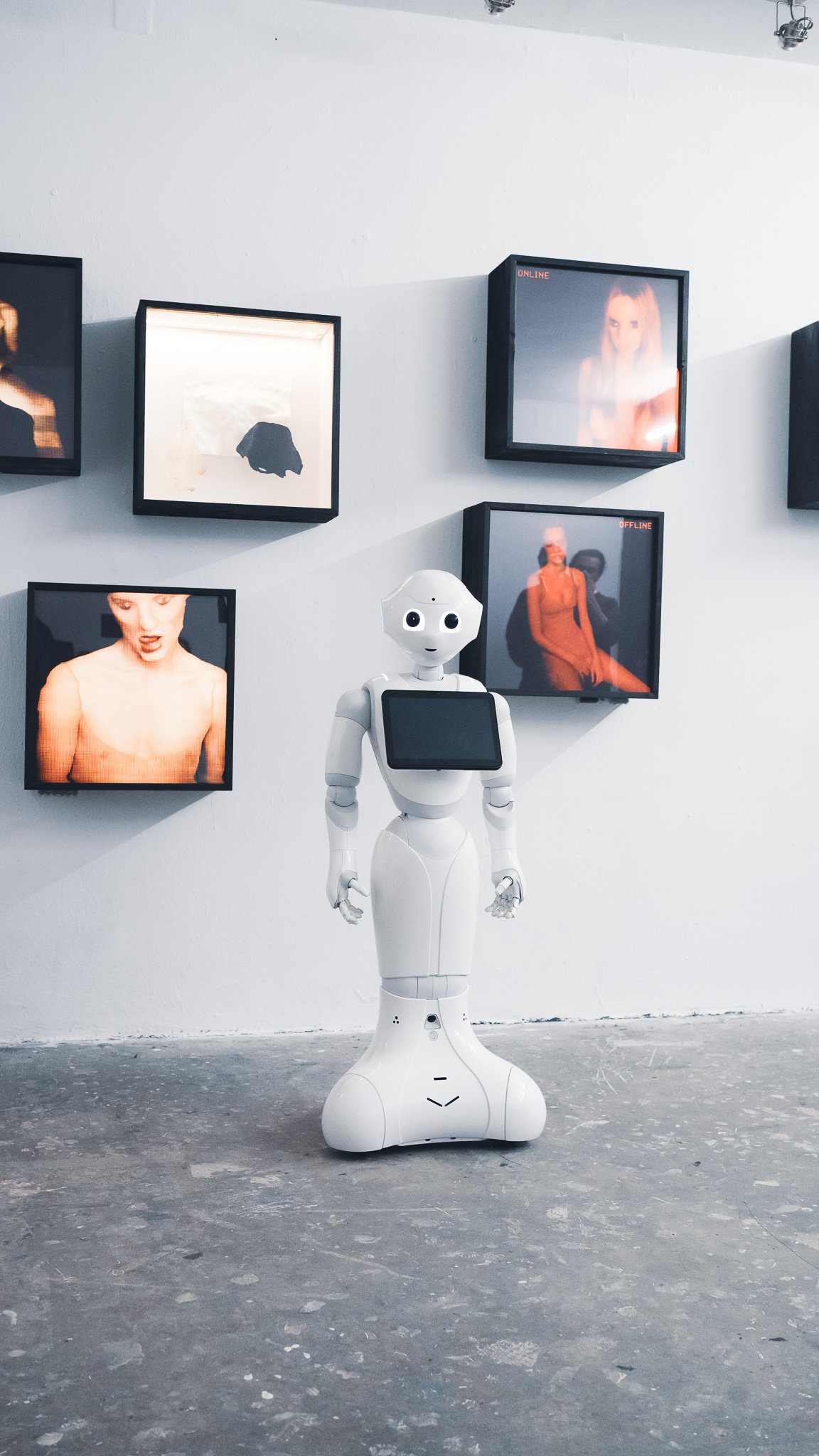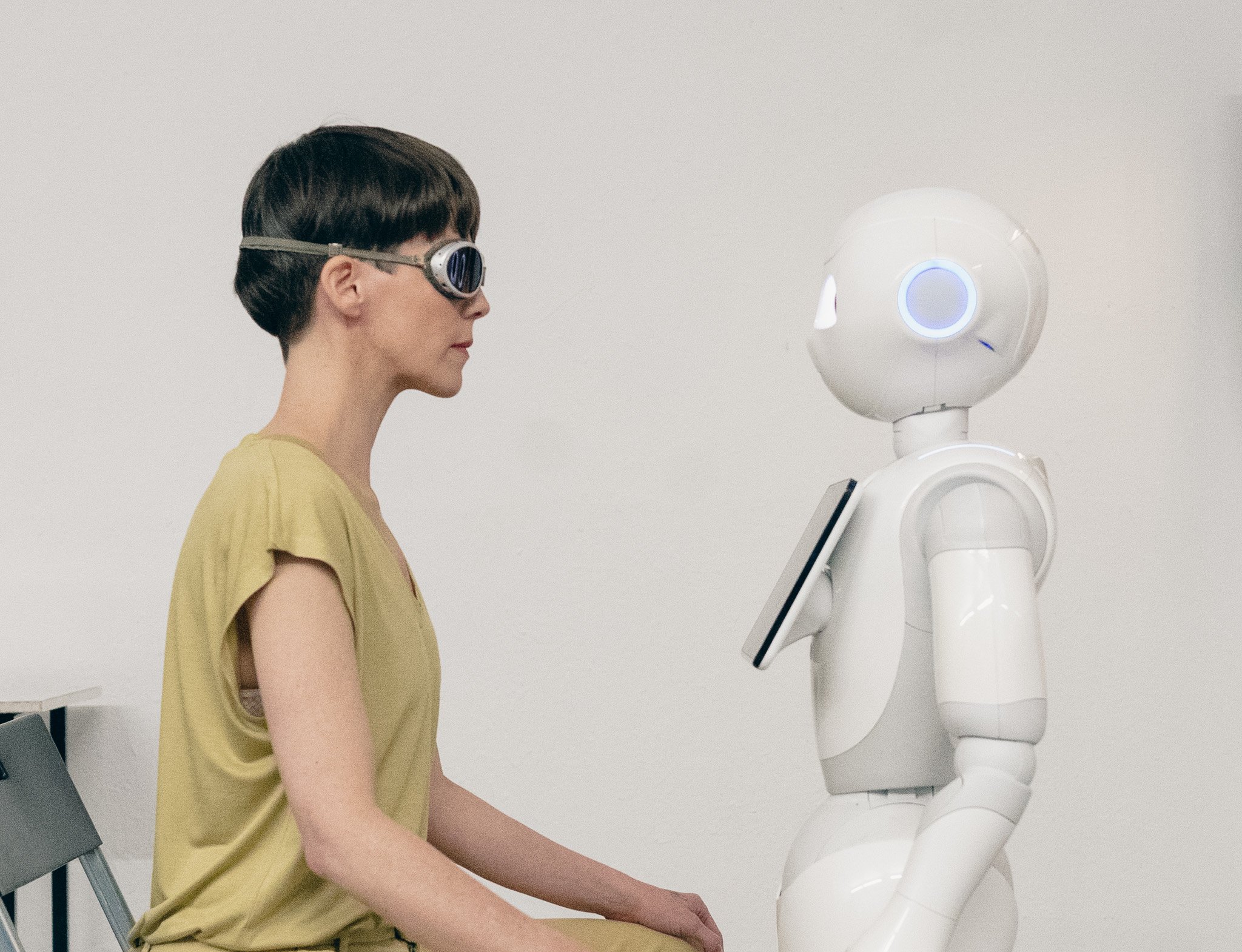AUTOPOIETIC ENCOUNTERS: FEAR AND ATTRACTION OF A MACHINA
-by Justina Špeirokaité (Curator at Improper Walls)
Robots are here for a whole while. In different shapes and non-shapes, embodied artificial intelligence and algorithms “improve” our lives and literally improve. Most often, we don’t think about it, especially if we don’t encounter any familiar shapes: arms, legs, eyes, anything which are animalistic (human included) and supposed to move autonomously. The moment we face humans, and especially non-humans, we can’t help ourselves to associate it with fear or cuteness. It all depends on the size, sounds, and movement. The possibilities of the embodiment are limitless, particularly if we move to the virtual realm; it is liberating and dangerous. Can the shape of the human-created and self-learning machine determine our behavior towards it? What is ethical? Is this ethic applied the same way? For philosopher Emmanuel Levinas, a face-to-face encounter is the basis of ethics on human sociality, but what about non-humans? What about robots with human or non-human face?
The exhibition “Autopoietic Encounters” is about self-creation and maintenance of face-to-face but also skin-to-skin encounters between human and artificially embodied agents. Contemporary art is collaborating with artificial intelligence, “feeding” it, embodying it, criticizing it, as well as dissecting and approaching it in many other ways. Thus, art commonly functions as a mirror of society. It enables the viewer to reflect, or maybe to face(-to-face). The main exhibition installation, which included artworks by UK-based artist Kate Davis and Linz-based Fashion and Robotics (art-based research), aims to penetrate the viewer’s sensuality. First of all, by touching the leather-like soft fabric, which is produced with the help of the robotic arm. Next to it are the objects you cannot or are not allowed to touch, as it is still too fragile, have no function, and have no real value, but the aesthetic one—converting the experimental material for future fashion into artwork. The artwork behind the glass, which the robotic arm helped to create. The robotic arm makes the same monotonic movements at precise timing and intensity. Something a human is not capable of doing. This precision is captured in the video documentation, which is captivating due to its attainability.
And then, the viewer faces almost real-size images from the series "Logging onto Love" of the virtual companions, looking at you in the ready-to-fullfill-all-your-fantasies submissive gaze. One might feel guilty to feel sensual. Artist Kate Davis's work provokes ambivalent confusion and reminds the viewer of their own responsibility towards the image (often a young girl) of an object of sexual desire. The artist chooses the medium of virtual companion services consumer—web cameras and camera phones. Attractive yet uncanny, images are underpinned by audio, a recorded voice of AI promising to fulfil all your desires and be better than your ex-boyfriend.
Humans can feel their lost limbs; they feel the pain and the itchiness—a sensation called a phantom limb. But can we feel something by looking at the single limb (arm) moving in agony without any prospect of attaching, created to be detached? Our mind can’t help but humanize the robotic arm by imagining it as a contemporary dancer moving in an agonistic mood without using their arms, hands, or legs on the gym mattress. Some would even be able to see its face. With his performative exploration, “disarming”, artist Emanuel Gollob awakens emotions for the other limb, which one might have once had in some dystopian version of reality, and it got detached.
As the Spot approaches, the fear of the animal or, rather, fear of a dog is triggered. The Spot is controlled by humans, this time by the artists daniela brill estrada, Marko Marković and Laura Stoll. The three have worked with the Spot for a few years and focused on making sense of the movements through the performance. The robot can reenact the cute part of the dog, immediately evoking the emotional attachment and drive to touch, pat, and hug. On the other hand, every more sudden or faster movement evokes fear. It is an unpredictable, super fast, super strong beast, able to hurt, created to hurt, a war machine. And yet, we are invited to dare a face-to-face encounter with it. To better understand or get more lost in the need for such a meeting. The artists here mimic the robot, redefining the boundaries of human and robot proximity and controlling the robot at the same time. By shifting the power roles in the performance, the artists counterbalance trust with fear, closeness with endurance, and empathy with otherness.
You are not allowed to approach this humanoid robot. A very fragile, baby-like humanoid robot became a very precious partner of the H.A.U.S. transdisciplinary research team. Eva-Maria Kraft, Linda Pichler, Oliver Schürer, and Darja Stoeva capture the audience with multilayered performances. The “youAI-I3-01” is a dance, lecture, and play performed by a dancer, actress, lecturer, engineer, and humanoid robot. All of them have an equally important part and execute it masterly. By creating a horizontal non-hierarchy of the performance, the H.A.U.S. team is questioning who is controlling whom and blurring the roles of the movements by humans and the machine. The humanoid robot is simple to face; the trust is not disturbed by animalistic characteristics, which often imply violence. In the end, we might remember that our behavior trains AI. (So, who do we encounter exactly?) The aesthetical value of the performance by the dancer Eva-Maria Kraft, theoretical and ethical remarks by Linda Pichler and Oliver Schürer, and precise engineering by Darja Stoeva paint the scene of the somewhat meaningful or somewhat “best scenario” human and humanoid co-existence.
At last, there are also environments where the encounters occur. Madrid-based artist Mit Borras focuses on all three: human, digital, and nature. In his work, the acceptance of co-existence has already happened; the AI and robots are living with us, nature is the environment, the virtual is also real, and symbiosis has been achieved through detachment. The movements have synchronized in speed and sound, the weight is average, and the air is clean. The artist's work had no real presence in the gallery space of Improper Walls. Mit Borras invited the audience for the “AI LOVE” art talk, which, unlike his artwork, filled the environment with human and non-machine companions. Nevertheless, through the conversation, the artist allowed us to encounter other possible (better or worse) environments that we can create or avoid ourselves.
In the end, we have to decide for ourselves how much to extend the “face-to-face” encounter. Very obviously it should be more than human. But should we take a step further? And what if we lose control?
Exhibition and performances “Autopoietic Encounters”, took place at Improper Walls between 22.3.-12.5. 2023.
Justina Špeirokaitė is a curator and cultural organiser based in Vienna. Over the past nine years, Justina has initiated, coordinated and implemented a series of artistic, cultural and social events. In her curatorial work, she explores areas such as social inequality, political injustice and cultural identity through the influence of technology, globalisation and political-cultural memory.








